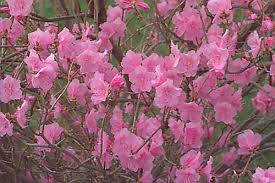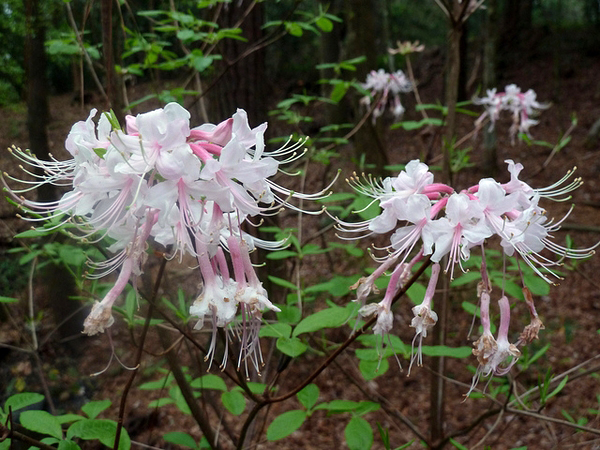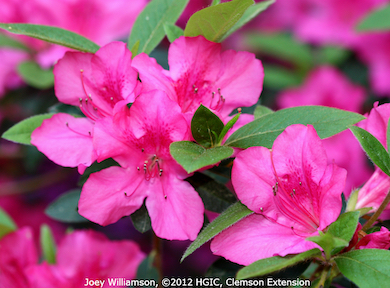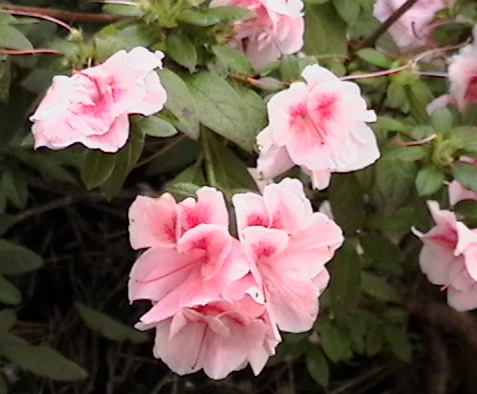Unique and Beautiful Azaleas and Rhododendrons
By Carolyn R. Casey, Fairfax Master Gardener Intern
Are you looking for another unique specimen plant to add to your garden, with beautiful and fragrant flowers? Or perhaps you enjoy the beauty of azaleas that bloom in the spring and then again in the fall. The shapes of the flowers and the unique colors of these rhododendrons and azaleas will make beautiful additions to your garden. Rhododendrons and azaleas have the same genus name. The genus name comes from the Greek words rhodo meaning rose and dendron meaning tree.
Deciduous Species

Rhododendron mucronulatum
Rhododendron mucronulatum, known as Korean Rhododendrons, are native to Korea, Japan and northern China. They thrive in the northeastern part of North America and grow well in Zones 4 to 7. They can grow 4 to 8 feet tall and 4 to 8 feet wide and bloom in April, with beautiful fragrant pink, purple or lavender blooms that emerge prior to the foliage. The leaves are aromatic when crushed, while their colors may vary from gold, yellow or green. They turn a beautiful red or burgundy in the fall. They like acidic soil that contains humus and is rich in organic material.
R. austrinum, known as Florida Azaleas or Florida Flame Azaleas, originated in the lower southeastern United States. They grow favorably in Zones 6 to 9 and are 8 to 10 feet tall and 8 to 10 feet wide. They bloom in April with a beautiful lemony, fragrant scent and clear yellow, cream, gold-orange or almost red flowers that emerge prior to the foliage. Leaves range in color from gold, yellow, green and orange and then are gold, yellow or bronze-orange in the fall. The cultivars are ‘Don’s Variegated,’ ‘Firecracker’ and ‘Lisa’s Gold.’ They are pollinated by hummingbirds and bees, are drought tolerant and prefer acidic and sandy soil.

Rhododendron canescens
R. canescens has many known common names, including Hoary Azaleas, Mountain Azaleas, Piedmont Azaleas, Pinxter Flowers, Florida Pinksters and Southern Pinxter Azaleas. They are native to moist woods, swamps and along streams that range from North Carolina to Florida and west to Tennessee, Arkansas and Texas. They grow well in Zones 5 to 9. They are 6 to 8 feet tall, but occasionally have grown 10 to 15 feet tall and 6 to 10 feet wide. They bloom from March to May with beautiful fragrant pink and sometimes white flowers, and the stamens can be two to three times longer than the petals. The blooms appear as clusters of 5 to 9 individual flowers that are 1 to 2 inches long and can have a musky-sweet and honeysuckle fragrance. They like soil that has a high organic matter and an acidic pH of less than 6. The leaves are dark green and change to a beautiful red and burgundy in the fall. Cultivars are ‘Varnado’ and ‘Varndo Pink.’ They can spread by stolons or runners. They are pollinated by hummingbirds and the swallowtail butterfly and like acidic soil that contains humus and is rich in organic material.
These deciduous shrubs have long tubular flowers that have long stamens extending beyond their petals. Because they bloom in the early spring, they are susceptible to spring freezes. It is important to plant them in an area that is protected from strong winter winds. Azaleas and rhododendrons are prone to root rot if they are not planted in well-drained acidic soil. If your garden has clay soil, it is best to plant them in raised beds to help prevent root rot and wet feet. They like partial shade since full sun can scorch their leaves, but they can tolerate two to six hours of direct sunlight a day. Mulching helps to keep their roots moist, since they should never be allowed to dry out, and also helps to maintain their soil temperature.
They are all pollinated by bees, especially the Andrena cornelli bee, the azalea miner. They are prone to insect damage from aphids, borers, lacebugs, leafhoppers, mealybugs, mites, nematodes, scale, thrips and whiteflies. There are some diseases that can also affect them including canker, crown rot, root rot, leaf spot, rust and powdery mildew. Always be sure to remove the dead or faded flowers so that the plant has sufficient energy to create buds for next year’s blooms. All parts of these plants are very poisonous, but deer still like to eat them.
Reblooming Azaleas
Are you aware that there are beautiful and colorful azaleas that bloom again in the fall? Fall or repeat blooming azaleas known as Encore Azaleas were introduced in the 1980’s and were developed by Robert E. “Buddy” Lee. His hybridization process started with selecting azaleas with fall blooming tendencies to be the seed parent plants. This fall flowering trait primarily came from R oldhamii ‘Fourth of July,’ a cultivar selected from seed collected in 1968 at an elevation of 2,500 feet on Taiwan’s Mount Tai Tun.
During the hybridization process, when an azalea started to bloom, the stamen of one of the flowers was removed to prevent self-pollination. To prevent cross-pollination from other azaleas’ pollen, a brown paper bag was used to cover the flower. After a couple of days, the bag would be removed so that the R. oldhamii pollen could be applied. The bag was placed back over the pollinated flower, and a seedpod would form that was harvested, dried and stored until March or April of the following year when the seeds were planted. Over the next four years, this hybridization process went from raising 7,500 seedlings to the first 12 named varieties of Encore Azaleas. The first Encore Azalea that was developed was named ‘Autumn Rouge.’

Autumn Amethyst
One popular Encore Azalea is ‘Autumn Amethyst.’ The female parent used to create it was a winter hardy hybrid named ‘Karens,’ a cross between ‘Hinodegirl,’the old Japanese Kurume variety, and R. yedoense var. poukhanense, the Korean azalea. Lee selected the seedling that was to be named ‘Autumn Amethyst’ in 1986 but did not receive the plant patent until 1998. More recently, there are several nurseries that are introducing their own varieties of fall blooming azaleas.
Evergreen azaleas such as the Encore Azaleas can be a wonderful landscape choice because they are easily maintained and are consistent performers. While fall blooming azaleas are available in a variety of different sizes, they are usually 5 feet tall and 5 feet wide. They come in a large selection of colors, and their blooms are usually larger than 2 inches, with single or double blooms. They first bloom in middle to late spring and then bloom again in the fall, from late September until late November.

Encore ‘Autumn Belle’
Fall blooming azaleas like to be planted in an area where they have bright light to full sun during the early part of the day; however, they need some protection from the hot sun in the late afternoon. They prefer soil with a pH below 5.5 that is well-drained and acidic with additional organic material. They need to be watered regularly during their growing season. After their spring blooms have faded, prune back these azaleas and fertilize them with a slow release granular azalea and camellia fertilizer. This promotes new growth and helps with bud formation for the fall blooms. They thrive and are winter hardy in zone 7 and throughout the South.
My beautiful ‘Autumn Amethyst’ azaleas bloomed this spring. They also started reblooming this August and are still in bloom. Happy gardening with these unique and beautiful additions to your garden!
Resources
• Rhododendron mucronulatum, Gardener Plant Toolbox, North Carolina State Extension
• Rhododendron austrinum, Gardener Plant Toolbox, North Carolina State Extension
• Rhododendron canescens, Gardener Plant Toolbox, North Carolina State Extension
• Rhododendron mucronulatum ‘Cornell Pink,’ Missouri Botanical Garden
• Rhododendron austrinum, Missouri Botanical Garden
• Rhododendron canescens, Missouri Botanical Garden
• Plant of the Week: Rhododendron Fall Blooming Azaleas, University of Arkansas Division of Agriculture,
Research and Extension
• Plant of the Week: Encore Azalea, Gerald Klingaman, University of Arkansas Division of Agriculture,
Research and Extension
• Selecting and Growing Azaleas, University of Georgia Extension
• New Azaleas Extend Blooming Season to Autumn, Robert E. Lee and Aimee Coker, Virginia Tech